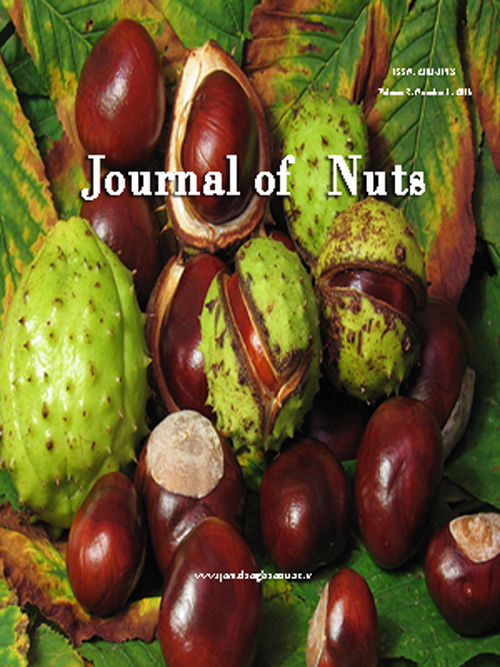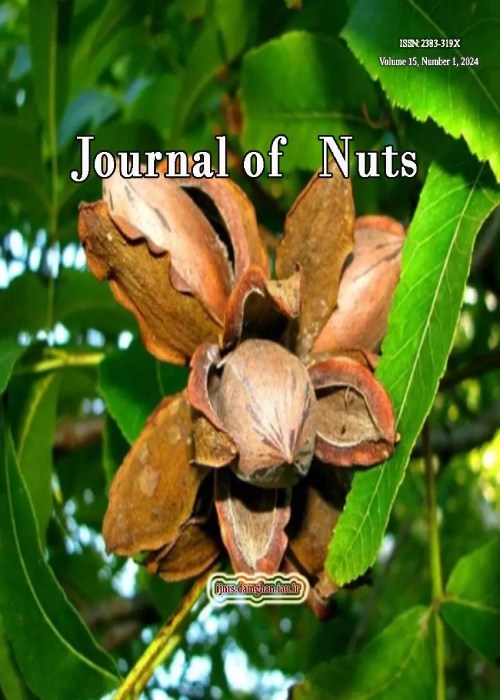فهرست مطالب

Journal of Nuts
Volume:13 Issue: 3, Summer 2022
- تاریخ انتشار: 1401/05/28
- تعداد عناوین: 6
-
-
Pages 167-181In this research, the effect of two irrigation treatments (90 and 40% of available water) and four different levels of zinc (control, 5, 10, and 20 mg kg-1 soil) was investigated on pistachio rootstock seedlings including ‘Akbari’ and ‘Badami’ in a completely randomized design with four replications during 90 days. At the end of the experiment, plant growth characteristics including shoot height, stem diameter, number of leaves, leaf area, and dry matter accumulation in root, stem, and leaf were evaluated. Additionally, the relative water content, membrane stability index, photosynthetic pigment concentrations, and content of organic osmolytes were appraised as well. The results showed that drought stress reduced plant height, number of leaves, leaf area, and biomass of plants, and increased root dry weight. The zinc application increased plant growth under irrigation treatments. In addition, under drought stress, the application of 5 mg kg-1 zinc increased the membrane stability by16.76%, maintained chlorophyll a by 20.69%, b by 31.96%, and total chlorophyll of the leaf by 27.74%. However, the application of 20 mg kg-1 Zn in soil caused toxicity and exacerbated the effects of drought stress which led to the accumulation of proline and soluble carbohydrates in the pistachio rootstocks with more proline in ‘Akbari’ than ‘Badami’ rootstock, while Zinc could reduce the accumulation of soluble carbohydrates and proline. In general, ‘Badami’ was introduced as a tolerant rootstock for use underwater stress, as well as using 5 mg kg-1 Zn to improve the growth and efficiency of both rootstocks under drought stress or without stress.Keywords: ‘Akbari’, ‘Badami’, Pistacia vera L, Proline, Soluble carbohydrates
-
Pages 183-197To investigate the effect of sulfur (S) and zinc (Zn) fertilizers on yield, fatty acid composition, and micronutrients of two peanut cultivars, a factorial experiment in a randomized complete block design with three replications was conducted in a farm in Guilan province, Astana Ashrafieh city in 2019 and 2020. The effects of S and Zn on peanut seed yield, fatty acids, and micronutrients were significant at the 1% level. The simultaneous application of Zn foliar application at a rate of 2 per thousand and S fertilizer at a rate of 40 kg ha-1 produced the maximum grain yield of the Spanish cultivar (with an average of 5770 kg ha-1). With an average of 5331 kg ha-1, the North Carolina 2 (CN2) cultivar produced the maximum yield when treated with 60 kg ha-1 of S and Zn foliar application at 2 per thousand. In terms of the number of fatty acids that make up the oil structure based on the average of the treatments tested, Oleic acid (56.9% in the Spanish cultivar and 61.1% in the CN2 cultivar) and Linoleic acid (28.6%) had the highest amount. The highest amount of palmitic acid was significantly higher in the treatment of the application of 40 kg ha-1 of S with a foliar application at 2 per thousand Zn (8.8%) and the lowest amount was found in the treatment without S and Zn (7.2%). According to the results of this experiment, both S and Zn factors were effective on most traits, so it is better to use Zn fertilizer if S is used to better absorb this element and can be effective in the growth and development of peanut plants. Therefore, simultaneous use of S fertilizer and Zn foliar application at high levels to improve the quality of fatty acids and grain micronutrients in the Guilan region is recommended.Keywords: Oleic acid, Oil, Iron, Peanut
-
Pages 199-210Agriculture plays a key role in Indonesia’s economy as it provides notable job opportunities for the people and contributes to the country’s foreign income. The Indonesian government initialized integration into the world economy through the implementation of development plans three decades ago. It has considerably influenced all economic sectors, including agriculture. Official data on nuts production shows that this activity has followed outstanding progress since the time that the plan came into force. Hence, the current study investigates the possible impacts of globalization on nuts production in Indonesia. To do so, we applied the non-linear autoregressive distributed lag model (NARDL) to two variables of interest, namely the nuts production and the KOF globalization index for the period 1975-2019. The main findings prove the existence of a long-run equilibrium relationship between the variables of interest. Moreover, the positive shocks to the globalization index have a direct impact on nuts production. In addition, we found evidence of the significant asymmetry between the globalization index and the nuts production in Indonesia, implying the significant difference between the effect of positive and negative shocks to globalization on nuts production.Keywords: Globalization, Indonesia, NARDL model, Nuts production
-
Pages 211-225Present research study was carried out with four walnut (Juglans regia L.) genotypes viz. KG (Kulgam), CS (Char-e-Sharief), KW (Kupwara) and TM (Tangmarg) from major walnut producing areas of Kashmir valley. The aim of the study was the selection of superior genotypes having better quality nuts and kernels with higher antioxidant potential. Nut and kernel quality traits were recorded. The results revealed that the nut weight ranged between 11.70 to 14.51g; nut diameter between 9.60 to 14.27mm; nut length between 17.40 to 20.51mm. The maximum variability was observed in nut weight, kernel weight, nut length and nut diameter. The fat content accounted for more than 60% of walnut kernel weight and ranged between 49.83 to 83.76%. The antioxidant potential, proximate and mineral composition, total phenolic content, flavonoids, as well as, flavonols, were all evaluated. Mineral content; zinc (Zn), iron (Fe), manganese (Mn), copper (Cu) and magnesium (Mg) were also determined. The total phenolic content varied between 19.8 to 50.19mgGAE/g while the total flavonoid and flavonols ranged from 188.5 to 815.08mgQE/100mg and 3.46 to 7.77mgQE/g, respectively. The walnut extracts (0.5mg mL-1) showed 82.60 to 97.19% DPPH (2,2-diphenyl-1-picrylhydrazyl) scavenging activity. This study demonstrates that owing to maximum nut and kernel weight, better free radical scavenging properties and higher phenolic profile of KW (Kupwara), this genotype seems to have a potential for production on large scale in Kashmir area.Keywords: fat content, Nut quality, plant extracts, Secondary metabolites
-
Pages 227-237The study was performed to investigate the Aspergillus growth and aflatoxin production in fresh pistachios stored in different packagings. Forty kg of fresh pistachios of the Abbasali cultivar were sampled and kept in different temperature conditions including 4°C and ambient conventional temperatures in plastic baskets or polyethylene plastic bags. Sub-samples were taken at 4 days intervals for 32 days to measure aflatoxin and evaluate the population of Aspergillus section Flavi. Aflatoxins were quantified by HPLC and the fungal population was monitored by dilution series method and AFPA medium. The results showed that on the first day of storage in all conditions the amount of aflatoxin was undetectable. Aflatoxin infection started on the fourth day after storage in the ambient conventional temperature and increased over time. The lowest production of aflatoxin B1 was in the 4°C treatment. Pistachios stored at ambient conventional temperature and packed in plastic baskets showed the highest amount of aflatoxin B1 production. The effect of the treatments on the production of aflatoxin B1 showed that the samples in polyethylene plastic bags at ambient temperature were the highest. The results showed that in the 4°C treatment, the fungal population was significantly less than in ambient temperature treatments. The lowest fungal population was in the 4°C plastic baskets packaged treatment. This treatment was not significantly different from the 4°C polyethylene bag treatment but was significantly different from other treatments (P≤0.01). In general, keeping fresh pistachio at 4°C and suitable plastic is trustworthy. Storage for more than 8 days in the ambient conventional temperature greatly increases the risk of fungal and aflatoxin contamination.Keywords: Food Safety, Contamination, mycotoxins, Nuts
-
Pages 239-245The lack of germination success and subsequent seedling recruitment of recalcitrant acorns of Brant’s oak (Quercus brantii) has been described as one of the main reasons for the cessation of sexual regeneration in Zagros forests. What happens to acorns whose viability is immediately lost is examined in the form of overwintering. In this study, overwintering conditions following seed dispersal were simulated by subjecting freshly harvested acorns with three moisture content levels (85, 90 and 100% fully hydration) at 3°C for up to three months. The results indicated that Brant’s oak acorns are totally recalcitrant and show no signs of dormancy. Their viability depended entirely on the moisture content. Fully hydrated acorns maintained a viability rate of more than 80% after three months of overwintering. This time period for acorns with 95% full hydration lasted only one month. At 90% fully hydration, the viability rate of acorns decreased almost immediately to less than 80%, and to less than 50 and 20% after 1 and 3 months, respectively. The passage of time was deteriorating during overwintering and its negative effects accelerated after one month, even for fully hydrated acorns.Keywords: Cold Storage, Seed fate, Seed moisture, Zagros


